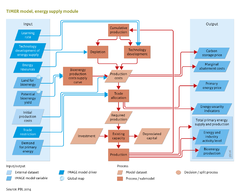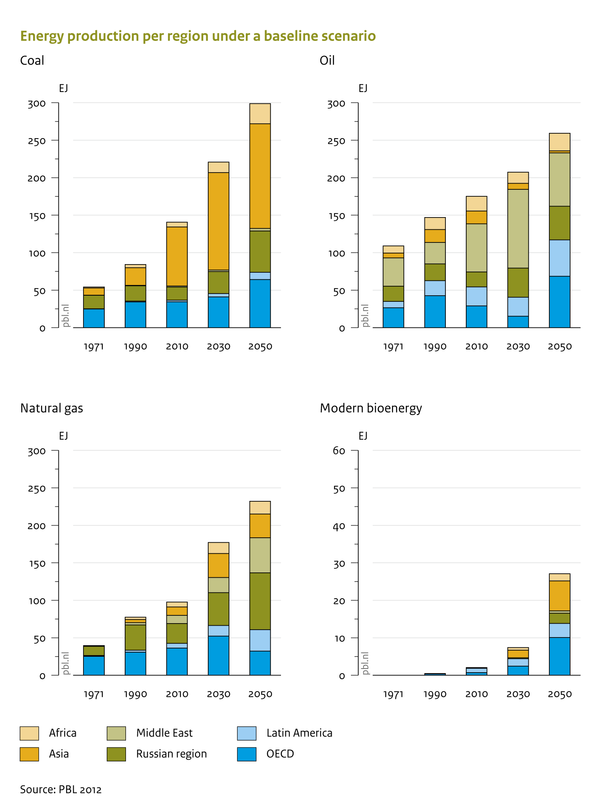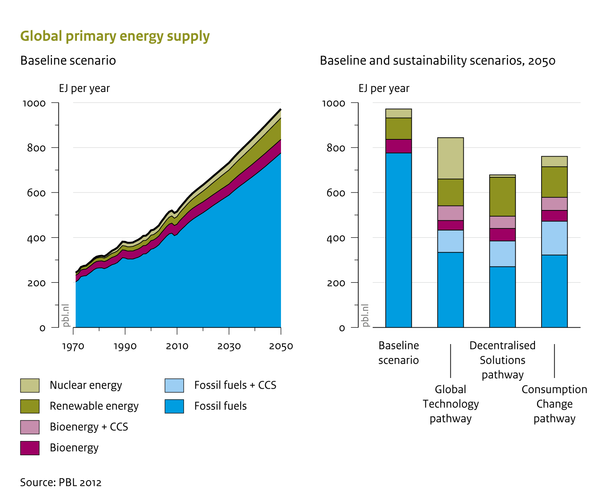Energy supply/Policy issues: Difference between revisions
Oostenrijr (talk | contribs) No edit summary |
Dafnomilii (talk | contribs) No edit summary |
||
| (One intermediate revision by one other user not shown) | |||
| Line 1: | Line 1: | ||
{{ComponentPolicyIssueTemplate | {{ComponentPolicyIssueTemplate | ||
|Reference=PBL, 2012 | |Reference=PBL, 2012 | ||
}} | }} | ||
== Baseline developments == | |||
<div class="page_standard"> | <div class="page_standard"> | ||
Under the baseline scenario, demand for energy increases rapidly, and as a consequence, supply is projected to increase in the coming decades for all energy supply options. Energy demand is, however, mostly met by fossil fuels: coal increases in production for most regions; oil also increases and moves to unconventional sources from Canada and South America; natural gas is expected to rise faster in production because it is presumed to be more abundant and increasingly cost competitive, with unconventional sources becoming increasingly important. Main gas producers are the United States, the former Soviet Union and increasingly the Middle East. | |||
Production of modern bio-energy is constantly increasing in different parts of the world. For solar and wind, the most rapid increase so far has been in western Europe, the United States, and China. In the future, parts of South America and India are expected to produce large amounts of renewable energy. Nuclear power is expected to remain roughly at the same level, and uranium production to remain more or less stable and rather evenly distributed across world regions. Finally, hydropower capacity shows a modest increase under the baseline scenario with large remaining potential is Asia, South America, and Africa. | |||
Production of modern | |||
{{DisplayPolicyInterventionFigureTemplate|{{#titleparts: {{PAGENAME}}|1}}|Baseline figure}} | {{DisplayPolicyInterventionFigureTemplate|{{#titleparts: {{PAGENAME}}|1}}|Baseline figure}} | ||
| Line 14: | Line 13: | ||
* Carbon tax. As discussed, a carbon tax can lead to significant changes in the demand for fuels and therefore, also supply. | * Carbon tax. As discussed, a carbon tax can lead to significant changes in the demand for fuels and therefore, also supply. | ||
* Restrictions on fuel trade. As part of energy security policies, fuel trade between different regions can be blocked. | * Restrictions on fuel trade. As part of energy security policies, fuel trade between different regions can be blocked. | ||
* Sustainability criteria for | * Sustainability criteria for bio-energy production may restrict production in water-scarce areas. | ||
* Production targets are mostly set to force technologies through a learning curve. | * Production targets are mostly set to force (renewable) technologies through a learning curve. | ||
The influence of stringent climate policy on production of primary energy resources is shown in the figure below. Climate policy leads to a major shift from a system mostly based on fossil fuels to an increase in the use of nuclear power, renewable energy, | The influence of stringent climate policy on production of primary energy resources is shown in the figure below. Climate policy leads to a major shift from a system mostly based on fossil fuels to an increase in the use of nuclear power, renewable energy, bio-energy and {{abbrTemplate|CCS}} technology. The choice of these alternative options depends on assumptions made in the model, as shown in the scenarios in the study [[Roads from Rio+20 (2012) project|Roads from Rio+20]] ([[PBL, 2012]]). Three pathways based on different initial assumptions emphasizes different combinations of primary energy carriers, each time within a stringent emission constraint. | ||
{{DisplayPolicyInterventionFigureTemplate|{{#titleparts: {{PAGENAME}}|1}}|Policy intervention figure}} | {{DisplayPolicyInterventionFigureTemplate|{{#titleparts: {{PAGENAME}}|1}}|Policy intervention figure}} | ||
Latest revision as of 15:55, 21 October 2021
Parts of Energy supply/Policy issues
| Component is implemented in: |
|
| Related IMAGE components |
| Projects/Applications |
| Key publications |
| References |
Baseline developments
Under the baseline scenario, demand for energy increases rapidly, and as a consequence, supply is projected to increase in the coming decades for all energy supply options. Energy demand is, however, mostly met by fossil fuels: coal increases in production for most regions; oil also increases and moves to unconventional sources from Canada and South America; natural gas is expected to rise faster in production because it is presumed to be more abundant and increasingly cost competitive, with unconventional sources becoming increasingly important. Main gas producers are the United States, the former Soviet Union and increasingly the Middle East.
Production of modern bio-energy is constantly increasing in different parts of the world. For solar and wind, the most rapid increase so far has been in western Europe, the United States, and China. In the future, parts of South America and India are expected to produce large amounts of renewable energy. Nuclear power is expected to remain roughly at the same level, and uranium production to remain more or less stable and rather evenly distributed across world regions. Finally, hydropower capacity shows a modest increase under the baseline scenario with large remaining potential is Asia, South America, and Africa.
Policy interventions
The model can simulate various policies on the supply side:
- Carbon tax. As discussed, a carbon tax can lead to significant changes in the demand for fuels and therefore, also supply.
- Restrictions on fuel trade. As part of energy security policies, fuel trade between different regions can be blocked.
- Sustainability criteria for bio-energy production may restrict production in water-scarce areas.
- Production targets are mostly set to force (renewable) technologies through a learning curve.
The influence of stringent climate policy on production of primary energy resources is shown in the figure below. Climate policy leads to a major shift from a system mostly based on fossil fuels to an increase in the use of nuclear power, renewable energy, bio-energy and CCS technology. The choice of these alternative options depends on assumptions made in the model, as shown in the scenarios in the study Roads from Rio+20 (PBL, 2012). Three pathways based on different initial assumptions emphasizes different combinations of primary energy carriers, each time within a stringent emission constraint.
Effects of policy interventions on this component
| Policy intervention | Description | Effect |
|---|---|---|
| Carbon tax | A tax on carbon leads to higher prices for carbon intensive fuels (such as fossil fuels), making low-carbon alternatives more attractive. | The energy supply will change from the use of carbon intensive energy carriers to the use of low/zero carbon energy carriers. |
| Change market shares of fuel types | Exogenously set the market shares of certain fuel types. This can be done for specific analyses or scenarios to explore the broader implications of increasing the use of, for instance, biofuels, electricity or hydrogen and reflects the impact of fuel targets. (Reference:: Van Ruijven et al., 2007) | A change of the market share of the selected fuel types to the predetermined values. |
| Implementation of biofuel targets | Policies to enhance the use of biofuels, especially in the transport sector. In the Agricultural economy component only 'first generation' crops are taken into account. The policy is implemented as a budget-neutral policy from government perspective, e.g. a subsidy is implemented to achieve a certain share of biofuels in fuel production and an end-user tax is applied to counterfinance the implemented subsidy. (Reference:: Banse et al., 2008) | |
| Implementation of sustainability criteria in bio-energy production (*) | Sustainability criteria that could become binding for dedicated bio-energy production, such as the restrictive use of water-scarce or degraded areas. | Application of sustainability criteria for bio-energy production, reduces the areas potentially suitable for the cultivation of bio-energy crops, and consequently the marginal costs of bio-energy use. |
| Improving energy efficiency | Exogenously set improvement in efficiency. Such improvements can be introduced for the submodels that focus on particular technologies, for example, in transport, heavy industry and households submodels. | Efficiency improvements result in a decreased energy demand, resulting in less need for energy supply. |
| Restrictions on fuel trade (*) | As part of energy security policies, fuel trade between different regions can be blocked. | Less fuel trade will result in a change in fuel prices and availability. |


